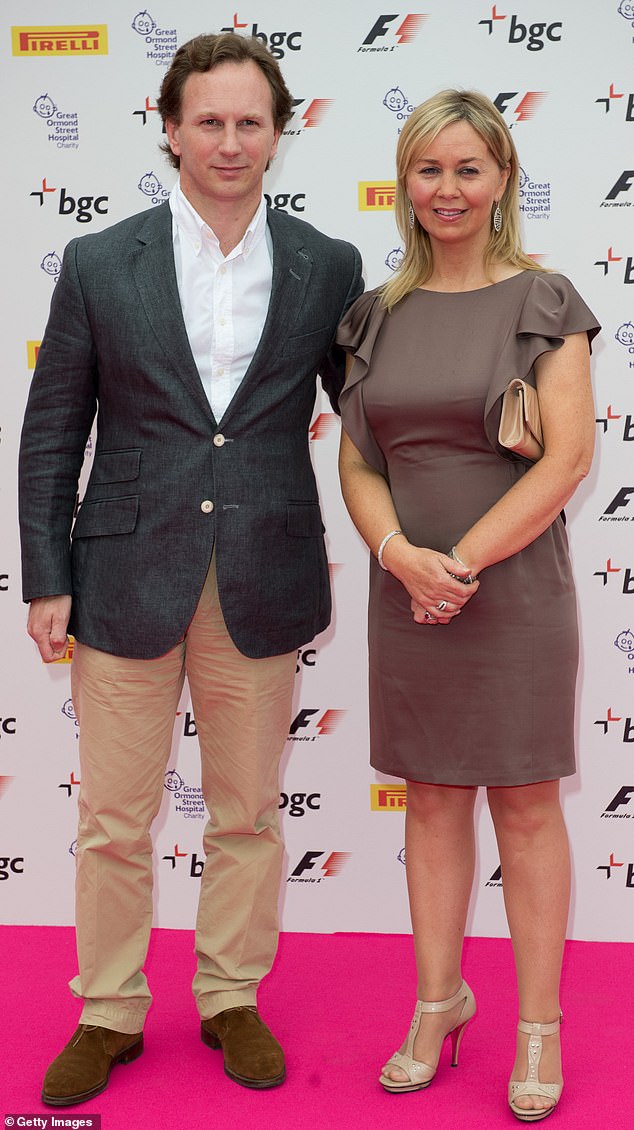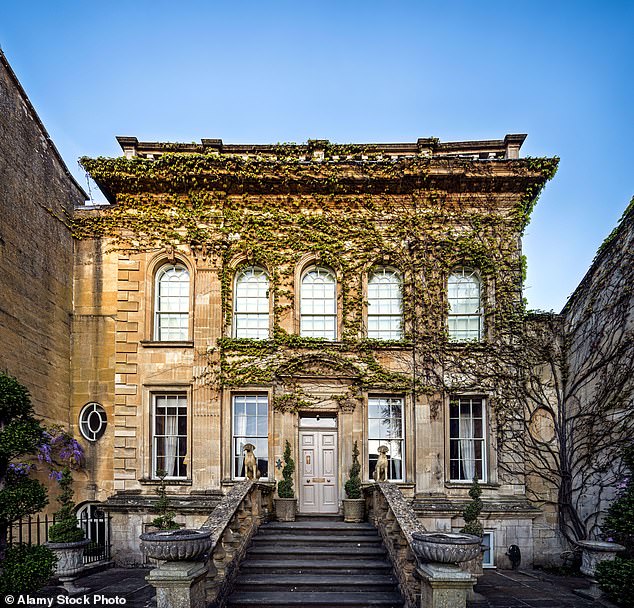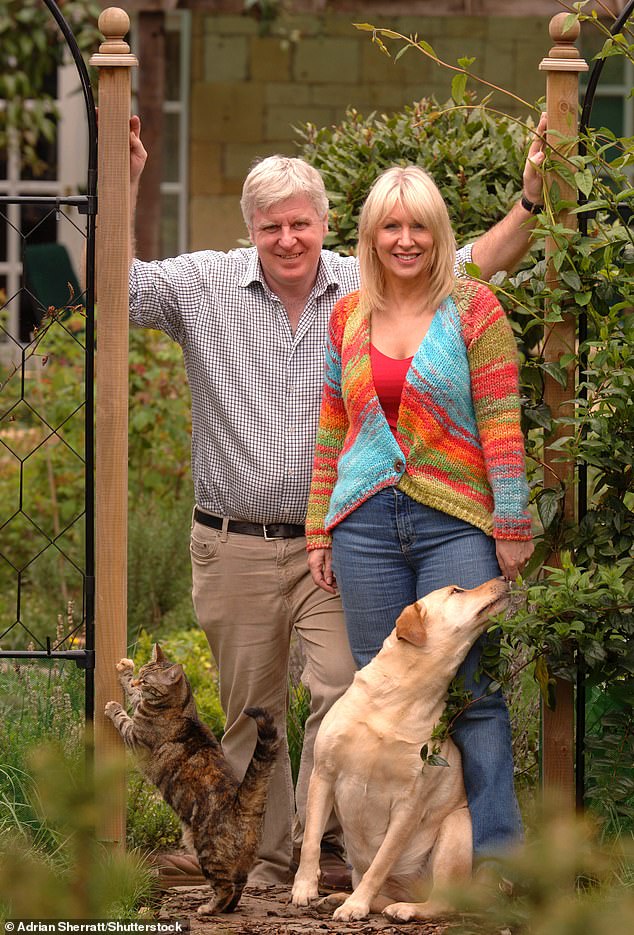Do you believe a house can be haunted or cursed? I didn’t – until I lived in one.
Last month, I read about the tragic death of Beverley Allen, the first wife of former F1 boss Christian Horner and mother of his teenage daughter, who passed away at 58 after a cancer battle.
And I discovered that Beverley had been living in what was our former family home. It brought so many memories rushing back. It was the house where, for almost five years, my husband Paul and I had lived, unhappily, with our three daughters. A house with a chequered, if not tortured, history.
We had stumbled upon it by accident in a Gloucestershire village in 1993. In fact, when I think back, it happened all too quickly and easily.
We were on our way to a friend’s one evening when I saw it, the honeyed Cotswold stone facade bathed in the glow of lights placed beneath two cherry trees.
I was bewitched. I shouted to Paul to stop the car and made him reverse back down the High Street to stop outside so I could scribble down the phone number from the Knight Frank ‘For Sale’ sign attached to the outer railings.
Paul was confused. Why was I interested in such a grand house. I told him: ‘Why not? After all our hard work, building up our business, why shouldn’t we live in a house like this?’
We were both from working-class stock, but for Paul it was ‘other people’ who lived in grand houses, while that was the lifestyle I’d aspired to.

Former F1 boss Christian Horner in 2012 with Beverley Allen, his first wife and mother of his teenage daughter, who passed away at 58 after a cancer battle
It was the reason I worked so hard. I wanted something better for my children than my own childhood, growing up in the poorest parts of Liverpool and then in the concrete council estates as inner-city slums were cleared in the Sixties. This Georgian gem situated on a beautiful High Street in the Cotswolds was as far removed from where I’d grown up as it was possible to get.
It’s fair to say Paul was never totally sold on the house. ‘It’s like a Liverpool tart,’ he whispered to me on the day we viewed it. ‘All fur coat and no knickers.’ He was referring to the fact that the house was in fact a terrace, albeit a rather grand one, with a 2.5-acre garden.
As Kirstie Allsopp might say, it had kerb appeal in spades. It was a grade II-listed building dating back to the 18th century and described in detail in various architectural guides.
Long and narrow, it was no wider than an average home, with a basement, two bedrooms on the first floor and three on the second.
During the viewing, as we strolled the empty rooms and stood beneath a cobwebbed chandelier, the agent told us it was a ‘trophy house’. As shallow as it sounds, I fell for this sales patter, hook, line and sinker.
Paul was a man who was a firm believer in the old adage that a happy wife delivers a happy (and quieter) life, and so despite his reluctance we moved in weeks later.
On the first night, after the removal vans had left and our three young daughters were asleep in their new rooms on the second floor, we opened a bottle of champagne and dined on fish and chips. As we clinked glasses and surveyed our surroundings, I said: ‘How can life be this good? I never thought it was possible to be so happy. It can’t last, can it?’
I’ve never forgotten that moment because, as I’ve come to realise, that was when everything changed.

‘It’s fair to say Paul was never totally sold on the house. “It’s like a Liverpool tart,” he whispered to me on the day we viewed it. “All fur coat and no knickers,”‘ writes Nadine Dorries
Within months, we found ourselves having to deal with sad and challenging situations that came at us out of the blue: bereavement, illness – and our children’s growing unease in their new home.
I was also finding it impossible to make the house cosy or homely. With its tall ceilings and windows, it felt permanently cold and cavernous.
The first blow was the loss of Paul’s mother, Doll, the matriarch of our wider family and the best mother-in-law any wife could wish for.
A few months after we’d moved in, she and I were in the garden chatting when I noticed that she was slurring her speech. I booked an appointment with the village GP and a week later she was diagnosed with a brain tumour. She died soon after. It devastated us.
Then Paul, just 42, was diagnosed with a debilitating health condition. We were beginning to feel as if we were no longer in control of our own destiny.
I wanted to know more about the history of our new home and an elderly neighbour, who lived two doors down, was happy to fill me in – indeed she had previously lived at the house, arriving there as a young bride in the 1940s.
She regaled us with its history – and what a tale it was. The family who had built it in the 1700s had quickly found themselves in a precarious financial position and were forced to take out a bond to the sum of £4,000 (equivalent to £670,000 today).
This family, she told us, had been blighted by early deaths of male heirs, subsequent death duties and became, according to a local author, ‘a wild and gambling lot’.

‘Paul, just 42, was diagnosed with a debilitating health condition. We were beginning to feel as if we were no longer in control of our own destiny,’ writes Nadine
Our neighbour also confirmed what we had previously thought to be an apocryphal tale, that the original owners had lost the house in a bet on a horse and that was how it came to be in the possession of her family in 1831.
We discovered it had almost burnt down twice – on both occasions with near catastrophic consequences.
Our neighbour’s own life had been far from happy there and she told me her husband had run off with a corset model from Brighton. Our time in her former home continued in a similarly unhappy vein. Within two years, we were a long way from the couple happily raising champagne glasses. Paul had become chronically ill, and our family support network was disintegrating due to illness and death. Every day there was a new mountain to climb.
And our children were clearly unhappy.
One day, one of my daughters told me that ‘someone’ had whacked her hard on the shoulder twice when she was alone in her bedroom. She would never sleep there on her own again.
We blamed her sisters playing a trick on her, but to this day, as adults, they vehemently deny it. And they had their own stories to tell.
We were blighted by fire alarms going off in the bedrooms in the middle of the night, and no matter how often we called in the electrician, it was never resolved. We were only too aware of the two previous fires in the house.
One night, the alarm on the girls’ landing went off and one daughter told us that she heard everyone was calling her to get downstairs, but she couldn’t move because it felt like something, or someone was holding her down in the bed. It wasn’t the first time she’d experienced it, she said.
Our daughters came to hate their bedrooms. Night after night they would slip into our bedroom, or into the au pair’s room, to sleep. Someone who had lived in the house previously told me that her son had slept in one of the same bedrooms as my daughters and insisted on keeping the overhead light on every night. He kept telling her the rooms were haunted. They soon moved.
Hearing this, I was so concerned that I called in a priest, who blessed the house. He told me he’d advise anyone moving into an old house to do the same.
When I told my neighbour about all this, she wasn’t the least surprised. ‘Ah, well. Children are far more perceptive to these things than adults and they aren’t the first to be unhappy on that floor. The servants used to sleep up there. There are tales to tell. You should listen to the children.’
I never asked her: ‘What things or what tales?’ I think I was too frightened to ask.
In the end it became all too much. Five years after we first set eyes on it, we called the estate agent. He made a phone call – and had sold the house by 1pm.
That day we moved into another house we’d bought previously in the terrace. No one could understand why, and we were aware rumours in the village that we must be in financial trouble.
Why else would we leave the grandest and most beautiful property in the village – the ‘trophy house’?
I hated the speculation, but it was Paul’s decision. He cared nothing for gossip and it was my turn to do what was needed to keep my husband happy. He had never settled there. He drew more connections between the house and the troubled life we were living than I had, but then he was the yin to my yang. I was practical, he was sensitive.
Since Beverley Allen’s death, I understand that the house has stood empty. For all I know, she may have loved it and been very happy there, and I sincerely hope she was. Friends in the village tell me she was the loveliest woman and liked by everyone.
However, I’ve spent many years with that house on my mind.
Just before Paul died six years ago, we spoke about the places we’d lived here and abroad, and I asked him if he ever regretted us selling it, for not giving it longer. He was unequivocal in his reply. ‘No, there was something about that house,’ he said. ‘I felt nothing but relief.’
Logically, I know that a house is just bricks and mortar. A box with a roof where we spend our days until the next person or family comes along and takes up residence. But I’ve now come full circle: I agree with him that there was something about that house, for our family at least, although I can’t explain it.
But as a young nurse working on acute wards, I’ve held the hand of many during their moment of death, and I have seen and heard phenomena that are impossible to explain. It is undeniable that ‘stranger things’ can occur and we can read into them what we will. Ask any undertaker.
At Paul’s funeral, a sunny calm day in June, both back doors of the church blew open and smashed against the wall, just as the recessional music began to play. Later, I asked our funeral director what had happened. ‘I thought my men had opened the doors too early, but they hadn’t moved. Nothing surprises me. I can’t even begin to explain the things that happen at some funerals,’ he told me.
I’m practical and pragmatic, and so it hasn’t been easy to write this piece. But now, after downsizing, the search for my last ‘forever home’ is under way, and I’m determined to ensure it’s the right house for me.
One thing is for sure. Since the houses I’m looking at are all old, once I’ve made my choice, the first person over the threshold will be the priest.












